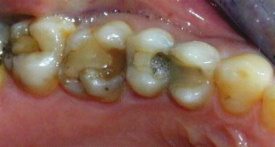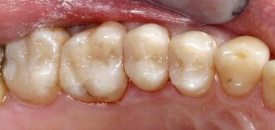Click here for page one: Basic information about white composite fillings
Questions and answers about amalgam fillings:
- Is the mercury in amalgam fillings toxic?
Answer: There is a controversy over the potential adverse health effects of silver fillings, which are close to 50% mercury and generally have about 40% silver in them. Although mercury is toxic, it has been thought that it was not released to the body during use as a filling material. Recent research, however, seems to show that these fillings release a very small amount of mercury vapor during chewing. Whether or not this amount of mercury is harmful to the body is a subject of controversy. Most people have some silver amalgam fillings in their teeth with no apparent adverse effects. No harm from the mercury in amalgam fillings has ever been absolutely proven. However, it has never been proved that it is not harmful, either. Many people are preferring the mercury-free fillings because of this health issue. I don’t believe that amalgam causes illnesses, as some people assert, but I couldn’t declare unequivocally that they are safe, either. - Are composite fillings weaker than amalgams?
Answer: This is another question that is loaded and highly controversial in the profession. The direct answer to this from me is yes, the mercury-free fillings or composite fillings are weaker than amalgam. However, if you take the total result—the filling plus the tooth—the composites are stronger because they bond to the tooth, making the tooth more resistant to fracture. - Should I tell my dentist I want white fillings?
Answer: My personal advice is not to ever be assertive with your dentist in telling him or her how you want your tooth restored. Listen to the options presented to you. Ask what your choices are and what the dentist recommends. If your dentist is not offering the white fillings to you as an option, there is probably a good reason. Many dentists do not feel comfortable using these composites on back teeth—they require special training to place. But if you press the dentist, he or she may say yes, they will place whatever restoration you want, in order for you to be happy, even though he or she feels uncomfortable with the procedure. That can result in serious problems.Before
After
Here is an illustration of why you need to be sure that your dentist is thoroughly familiar with composite bonding technology before having white fillings done. The first photograph shows a series of white composite fillings in teeth. The dark spots around them are where they are leaking and tooth decay is getting in around them. These fillings do not appear to have been properly done, leaving them vulnerable to leakage and new decay. They also appear to be wearing away, meaning that they may not have been fully cured. The second photograph, however, is where the fillings have been replaced using proper techniques.
This beautiful work was done by Dr. Craig Carlson, a mynewsmile.com dentist in San Antonio, Texas.
- How long have these white fillings on back teeth been around?
Answer: Their early history goes back to the 70s, well before the technology was available to do them well. In the mid-80s, technology was developed to bond to dentin and the materials were improved. I began placing white fillings on back teeth in 1984. While it is true that in the 80’s, these composite restorations were functionally inferior to the old silver amalgam restorations, that is no longer the case, provided that they are placed with proper technique by an experienced practitioner. - Why don’t all American dentists provide the composite fillings?
Answer: You can still graduate from many American dental schools without adequate training on doing white composites on back teeth. The reason the dental schools give for not including much about these techniques in their curriculum is that they are too busy preparing students for the board examinations and have no space in their curriculum for topics that aren’t required by those board examinations. So, in short, the answer is that the board exams don’t require them, so dentists have to go out, often after graduation, and learn these techniques from seminars, and dentists who are equipped with only the essentials from dental school don’t feel comfortable with the white fillings. For a listing of dentists trained in this new bonding technology, please see our referral page. - I have had one of these white fillings and my tooth was really sensitive afterward. Why?
Answer: Normally, the mercury-free fillings should have practically no sensitivity afterward—this is one of their chief advantages. There are several reasons they could be sensitive. For the full answer to this, please see our page: Tooth pain after filling, on this website. - Why does my dental insurance company pay so little on these mercury-free fillings?
Answer: You need to understand that your insurance company is not a non-profit benevolent society. They are in business to make money. Composite is more expensive to place, and the policy of many insurance companies is to cover the cost of the least expensive treatment, as long as that treatment is reasonably appropriate according to their definition. I don’t think they’re being entirely unreasonable in this. My experience has been that most patients who want the nicer fillings are willing to pay the difference, and I think it’s appropriate that they do. See our page of explanations of the costs of white fillings to learn more. You can also visit our page on the costs of cosmetic dentistry.
Read about one patient’s experience with severe pain in her teeth from the improper placement of white fillings.
Read about a dentist using pins in a tooth to help hold a filling in.
Click here to ask Dr. Hall a question.
This content was written by Dr. David Hall


